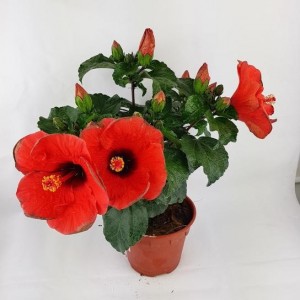The Hibiscus
 The scarlet hibiscus was the jewel among the potted plants on the corridor. Its striking beauty arrested the gaze of all who passed by. It reflected something of the glory of God, causing onlookers to express joy and wonder at its sight. This recognition and appreciation made the flower blossom all the more. It basked in the sunshine of that June morning, reminding me of the words of Robin Craig Clark. “Be like the flower; turn your face to the sun” and Georgia O’Keeffe, who wrote, “none of us can blossom without love and sunshine.”
The scarlet hibiscus was the jewel among the potted plants on the corridor. Its striking beauty arrested the gaze of all who passed by. It reflected something of the glory of God, causing onlookers to express joy and wonder at its sight. This recognition and appreciation made the flower blossom all the more. It basked in the sunshine of that June morning, reminding me of the words of Robin Craig Clark. “Be like the flower; turn your face to the sun” and Georgia O’Keeffe, who wrote, “none of us can blossom without love and sunshine.”
In spite of its delicate and soft petals, there was a strength and energy in the hibiscus that empowered and inspired me. No artist could replicate it, or capture on canvas its living spirit to empower, to influence, to spread joy and teach lessons of life.
The greatest lesson it taught me, was the shortness of life, because, after two brief days, it began to droop, wither and fold in on itself in sleep. Immediately, another hibiscus opened up to bloom forth on the same stalk. It was followed by another and another, each waiting while the previous hibiscus died. This reminded me of the expression, “life is a flower that never stops blooming” and the fact that the flowers were rooted in one pot, brought to mind the recommendation on a prayer card: ”Bloom where you’re planted.” (Francis de Sales).
The hibiscus is a tropical flower and also goes by the name of Rosemallow. I believe it is used as traditional medicine in parts of Brazil to regulate fertility in women. It is also used for lowering blood pressure. Like the hibiscus, we have no control over our beginning or end. Suzey Kassem reminds us of this.
“All things have an ending,
Every spark returns to darkness,
Every sound returns to silence,
Every flower returns to sleep with the earth.”
The Buddha said, “If we could see the miracle of a single flower clearly, our whole life would change.”
This, I believe, could be said in truth of the beautiful scarlet hibiscus I saw blooming on that far off June morning. Its image will always remain with me, because, as the poet, John Keats says, “A thing of beauty is a joy forever.”
Sr Una Rutledge, RNDM